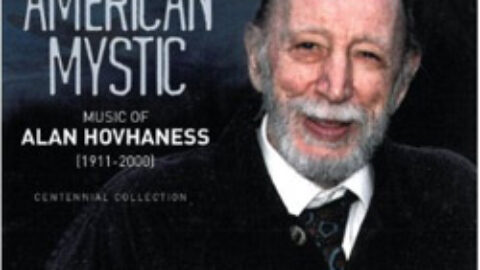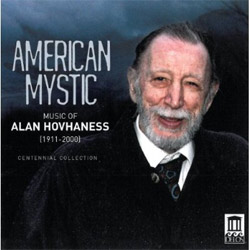 Alan Hovhaness would have been 100 this year, and for this occasion Delos is releasing American Mystic. Embracing his Armenian heritage, Hovhaness (1911-2000) studied a vast array of Eastern musical cultures, from Greece to Japan, South Korea to India, through a series of prestigious fellowships. The unique thing about this is that Hovhaness didn’t only limit his knowledge to the theory of the abovementioned musics, but he also learned how to play many instruments too (he was apparently quite proficient on the veena).
Alan Hovhaness would have been 100 this year, and for this occasion Delos is releasing American Mystic. Embracing his Armenian heritage, Hovhaness (1911-2000) studied a vast array of Eastern musical cultures, from Greece to Japan, South Korea to India, through a series of prestigious fellowships. The unique thing about this is that Hovhaness didn’t only limit his knowledge to the theory of the abovementioned musics, but he also learned how to play many instruments too (he was apparently quite proficient on the veena).
This new Delos CD is a beautiful collection of meditations, some intimate, some more monumental (it might sound antithetical but Hovhaness is that good). On the intimate side, one finds the delightful 4 Bagatelles, Op. 30, or his String Quartet No. 2, Op. 147 (only two movements are available: I and V). Performed impeccably by the Shanghai Quartet, the Bagatelles are evocative miniatures (3 min for the longest) reminiscent of Eastern folk themes or even lullabies. The two movements taken from the second string quartet composed in 1966 are somehow bolder and more spiritual albeit still modal in essence.

The monumental pieces on this album include his famous Symphony No. 2, Op. 132, Mysterious Mountain—Hovhaness’ Bolero. Indeed, not unlike Ravel he never considered this symphony his best work but he is still remembered for it (a scary thought for any composer). Back in the mid-fifties, when the piece was composed and premiered by Leopold Stokowsky, it was already a musical UFO. The Cleveland Orchestra performed the piece in December 1957 and one cold read soon after in the Cleveland News:
No dissonance, no noise, no discord – just beautiful sweeping harmony. The composer better watch out, he’s breaking the rules. He’ll probably be drummed out of the lodge.
Of course, there is more to this music than its modality and the second movement, the Double Fugue, is here to prove it. The craftsmanship in the counterpoint is remarkable and Hovhaness creates a vivid sense of excitement. In such moments it is very clear how much Hollywood film score composers owe to Hovhaness (Basil Poledouris?).
Another major piece is The Rubaiyat of Omar Khayyam (1975) for narrator, solo accordion and orchestra. Based on some of the 1,000 poems written in Persian by Omar Khayyam (1048-1131), the piece is less of a mystic nature and is more evocative of romantic episodes. The disc also features the Prayer of St. Gregory, Op. 62b and Charles Butler’s clear, nuanced tone on the trumpet brings majesty to what was originally intended as an intermezzo from Hovhaness’ opera Echmiadzin.

Hovhaness’ catalog also includes some incidental music, and a nice addition to this centennial tribute is The Flowering Peach, Op. 125. Originally composed for a Broadway play by Clifford Odet, the concert suite for chamber ensemble offers some wonderful pages: the beauty of the material exposed in Lifting of Voices could, for instance, make for a very effective solo saxophone piece.
The last piece on the CD is And God Created Great Whales, Op. 229, No. 1. As much as I really enjoy the rest of the album, And God… integrates some quite dangerous material: four recordings of whale sounds. Indeed, too many bad New Age recordings have included similar sounds in the past and it is hard to listen to this piece with a fresh ear, even with Hovhaness inventive orchestration (glissendi in the brass, etc.).
Overall, American Mystic is a great tribute to Hovhaness’s music and a necessary addition to one’s music collection. Delos worked very closely with the composer over the years and I feel that most of these versions can be seen as reference recordings. Besides, how many recordings of an accordion and orchestra piece do you own?
Alan Hovhaness, American Mystic (Delos Recordings, October 2011) – Buy on Amazon

























